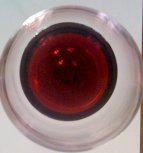Wine Tasting Tips
4 Steps To Rate Any Wine
Wine tasting tips really involve the evaluation of 4 key areas:
Sight
Smell
Touch
Taste.
We use the following wine tasting tips section when evaluating and recommending
wines to you and we score them using our own personalized rating system. After
you review this page, please click here to see how we rate our red wines.

1)Sight:
Sight is very important when evaluation wine and you will be concentrating on the Clarity, Color and Intensity of the wine.
CLARITY
The clarity or brightness to a wine is an indicator of its acidity and quality. Wines that display a cloudy or hazy look indicate possible contamination and or poor storage conditions. Fortunately, this is very infrequent today. Occasionally you may see crystals sticking to the cork or the bottom of your wine glass or wine bottle. They are harmless and usually indicate that the wine was stored in cold temperatures. We are experiencing a trend away from filtering so we are seeing more sediment in our wines.
COLOR
The color of red wines comes from the skin. The longer a wine ferments with its skin, (a process called maceration), the darker its color. Lighter color red wines indicate a higher acidity, lower tannins and readiness to drink. Color terminology for red wines as they age is as follows: Purple-Ruby-Garnet-Brick-Tawny.
2)Smell:
Most people do not realize this simple truth and important wine tasting tip but when we taste a wine we actually smell it. When you hear people refer to the "nose" of a wine they are actually referring to the smells. If the wine has intense aromas, it is said to have a "big nose". When working on your wine tasting scorecard, smell is one of the most important steps.
Now vigorously swirl the glass that is about 1/3 full to aerate the
wine. Make sure that you have the proper red wine glass for this. Now put your nose
right into the glass and inhale deeply.
Ask yourself:
*Is the aroma intense, medium or
vaguely there?
*Do I like the smell?
*What does it smell like?
Characteristic red wine aromas are many but here are some common one’s for you
to consider.
1) Red Fruit - Cherry, Raspberry, Strawberry and Currants
2) Dark Fruit - Blackberry, Black Currant, Blueberry, Plum and Raisin
3) Spicy - Licorice, Anise, Black Pepper, Cloves and Cinnamon.
4) Other common aromas - Woody, Smoky, Coffee, Tobacco, Chocolate,
Earthy and Floral.
3)Texture:
Texture or touch is how the wine feels in your mouth. Now sip and swirl the wine and make sure that it makes contact with your tongue and palate. The tongue is where the majority of our taste buds are. How does the wine feel?
Body
The body of the wine is the perception of its weight in your mouth. Does the
wine feel watery or full and heavy? Taking note of the body of the wine is an
important wine tasting tip and is important in food and wine pairing. For more
information please visit body of a wine.
Astringency
Astringency can be explained as the "puckering" sensation one would
have when drinking something like a strong tea. This sensation comes from the
tannins in the red wine. In some wines like Cabernet Sauvignon and Zinfandel,
the astringency can be quite strong.
Alcohol
Wines with higher alcohol content tend to be heavier bodied. A higher level of
alcohol in a wine can cause a burning sensation down the center of your tongue
when tasting. Higher alcoholic wines also tend to be bitter.
4) Taste:
This is where all your senses and wine tasting tips come together.
*How did you like the wine?
*Did you taste the fruit?
*Was it intense or vaguely there?
Balance
Evaluating the balance in the wine is where the true test of the wine makers
ability comes through. Balance is simply the measure of how the four major
components of wine, fruit, sugar, acid and tannin come together.
A good wine blends the 4 components together seamlessly and is an important
consideration and one of the most important wine tasting tips.
Finish
The final impression for your wine tasting scorecard is the finish. This
is the taste in your mouth after the wine has been swallowed.
If the finish last only a few seconds you are dealing with a simple everyday
wine. Generally, the more long lasting finishes will be present in higher
quality wines with a 20-30 second aftertaste being present. Some outstanding
wines can have a finish of over a minute or more.
Complexity
How many flavors can you detect in your wine? Some wines have many different
flavors and are referred to as being more "complex". A wine tasting
tip to remember is that wines that show greater levels of complexity are
usually much better quality, show higher flavor intensity and demonstrate
longer finishes.
Please visit us here to print off
your wine tasting scorecard.
Back to Red Wine Passion




